Paint. Heal. Grow.
October 2020
Summary
Our 20 years of observations, combined with study results, suggest expressive abstract art may help participants through any stage and with all types of grief. The Art4Healing® method uses abstract, expressive painting as a healing tool to give feelings like grief a voice when words fail.

Giving Grief a Voice through Expressive Painting
Grief is “deep and poignant distress caused by or as if by bereavement” (Merriam Webster, n.d.). In other words, we feel deeply distressed when we lose a loved one.
However, grief is not so easily defined. Grief can come in many forms of loss and the resulting feelings are varied, complex, and individual. Although grief is universal, it is nearly impossible to universally define and express in words.
Grief can be triggered by an actual or symbolic loss and can be felt individually or as a collective group. There’s no “universal path” through the grief process. Attempts to study and refine a model for the grief process continue.
Thankfully, there are other avenues for us to express our emotions, including art and specifically expressive abstract painting.
This Special Report discusses the implications of expressive abstract painting, specifically the Art4Healing® method, on the grieving process.
We’ll examine how the Art4Healing® method is compatible with different types of grief theories. We’ll also discuss how this method uses expressive abstract painting to help participants express any type of grief using the language of color.
Finally, we’ll look at a UK based cross study review of the impact of visual arts on the wellbeing of adults with mental health conditions. The review identified 9 aspects of wellbeing that this type of art positively impacts.
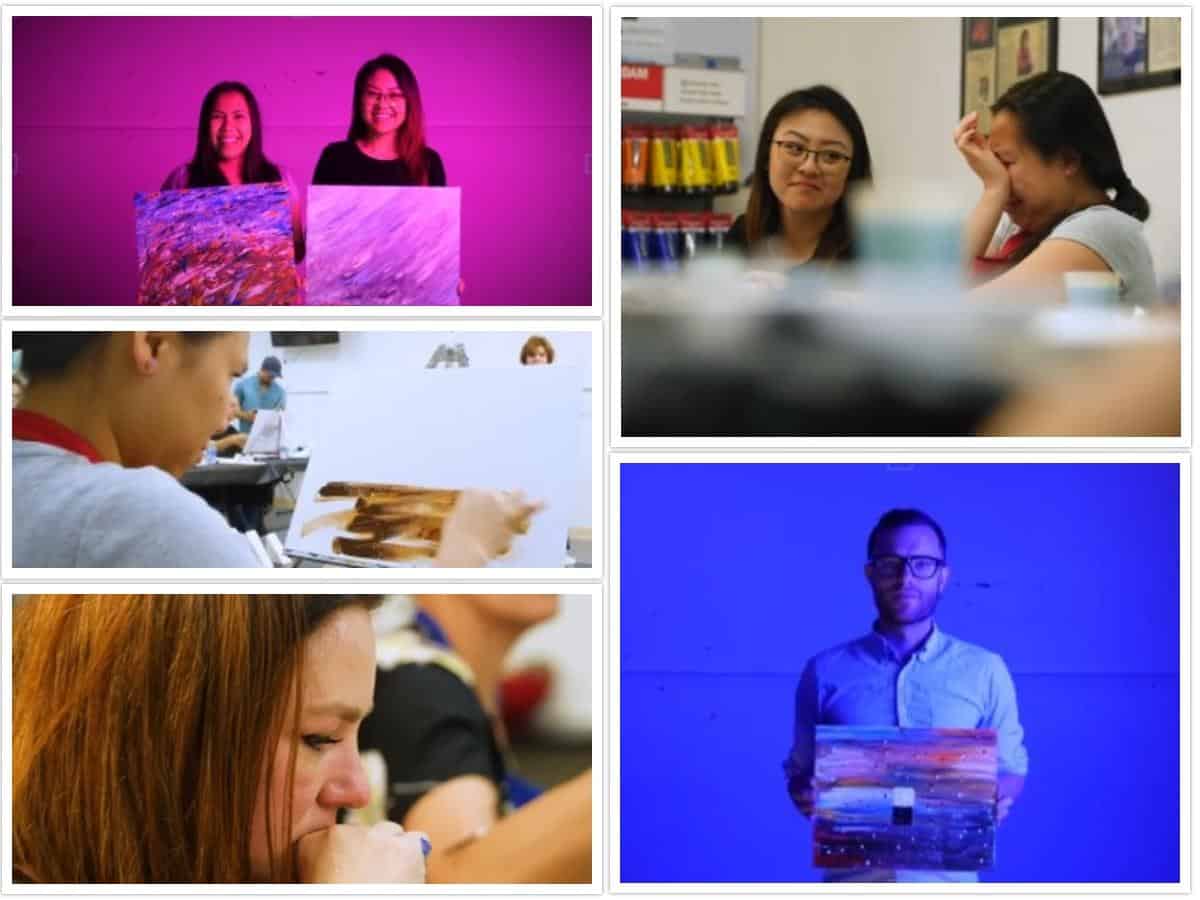
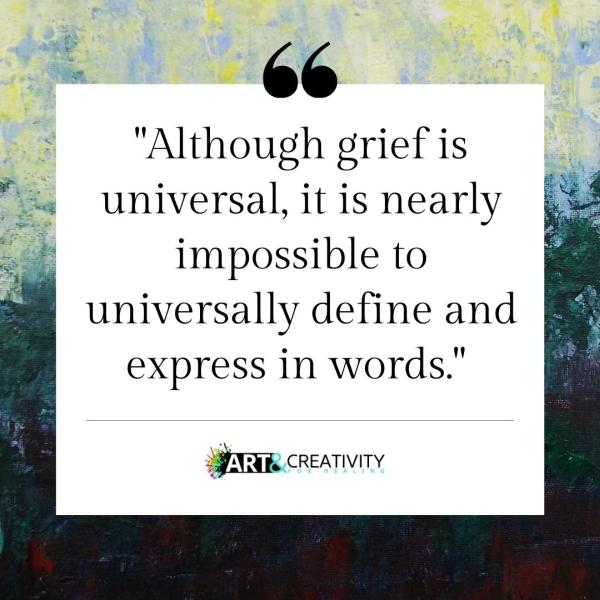
What is Grief?
Grief, although hard to define, has been studied extensively in the last century. Several models of the grieving process have been proposed, but people are most familiar with the “five stages of grief” model.
Grief Theories
The “five stages model of grief” was proposed by Elisabeth Kübler Ross in 1969. Kübler Ross studied terminally ill patients to come up with the stages we are familiar with: Denial, Anger, Bargaining, Depression, and Acceptance. The idea is by moving through the stages, a person learns to live with a loss (Kübler Ross & Kessler, 2005).
In the matter of grief associated with death, Kubler states that there are five stages (denial, anger, bargaining, depression and acceptance) and that the bereaved may not go through all five stages, nor follow the steps in sequence, and they might even experience a couple of the stages at once, or repeat one or more stages more than once (Gidlund).
It should be noted that the five stages model, while popular, isn’t the only grief model. Kubler’s model wasn’t backed by empirical study, and the study only looked at one side of grief from that of a terminally ill patient (Wikipedia, n.d.). However, the model is a good starting point for discussion due to its familiarity.
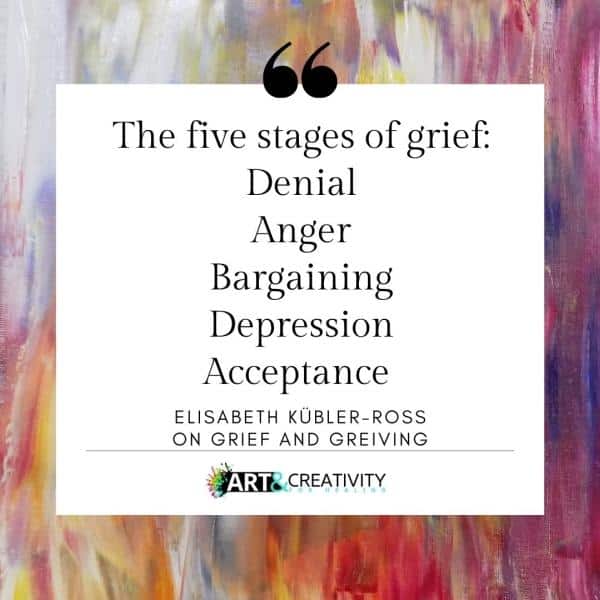
Early grief theories, such as those pioneered by Kubler Ross, paralleled the universalistic aspect of bereavement by conceptualizing grief as a predictable process of identifiable stages. However, research has increasingly informed a paradigm shift toward a more nuanced understanding of loss. A large body of empirical evidence indicates multiple trajectories of grief rather than one standardized process, and leaders in the field suggest that reactions to loss can be as varied as the bereaved individuals themselves (Weiskittle & Gramling, 2018).
In fact, grief can be specific to the individual, such as when “some people demonstrate considerable resilience when faced with loss, others experience significant but temporary impairment, and approximately 10-15% find themselves ‘stuck’ in a persistent state of intense, complicated grief” (Weiskittle & Gramling, 2018).
Every attempt to model grief has certain shortcomings because grief varies for each individual.

Types of Grief
The type of actual or symbolic loss a person experiences determines their path through the grieving process. Grief can arise from a physical or symbolic loss and can be experienced alone or collectively.
Bereavement and Symbolic Loss
Grief isn’t always related to a major event or a physical loss. Any loss of any magnitude, physical or not, can cause us grief. Loss comes in many forms, including loss of a loved one, loss of health, loss of a job, loss of family via divorce, and loss of freedom. Any time we can’t prevent a change or loss, we are subject to grief.
In 2020, symbolic losses came in many forms due to the coronavirus pandemic. Although many mourned the loss of a love one, many more mourned the loss of day to day routines, jobs, and the loss of certain freedoms.
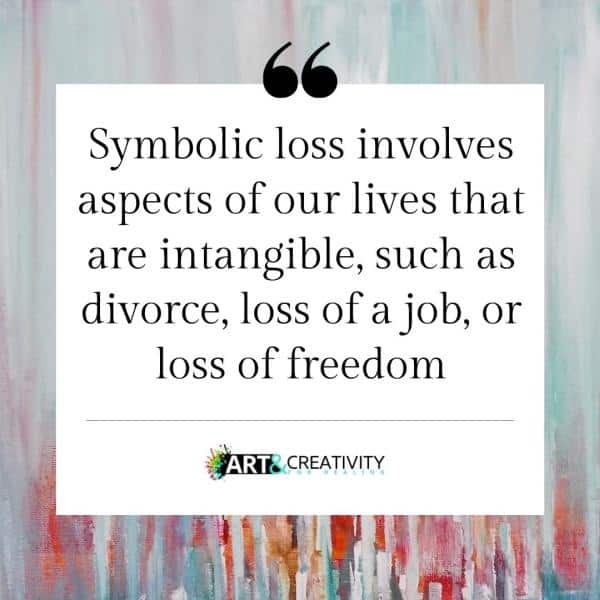
Collective Grief
When widespread tragedy occurs, collective grief can take hold. Similar to a virus, the feelings of loss and mourning spread through a community, impacting those outside of the initial impact. Wars, natural disasters, disease, and other mass casualty events can trigger a feeling of collective grief.
Here is a recent example of collective grief. A study was conducted by the CDC in July 2020 in their Morbidity and Mortality Weekly Report. It found that behavioral health concerns rose in June amid the coronavirus, compared to the previous year.
Among their results, anxiety disorder symptoms were 3x higher than the period in 2019. Depressive disorders were also up from 7 percent to 24 percent year over year. Over a quarter of respondents reported trauma or stress related symptoms related to the coronavirus pandemic. A further 13 percent reported increased substance use for coping with stress (Czeisler, Lane, Petrosky, & etal, 2020).
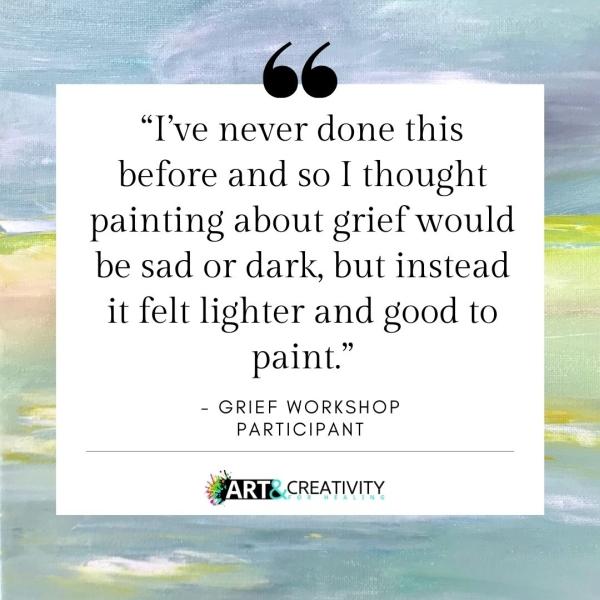
How Expressive Painting Helps Grief
Human experiences (including grief), and their portrayal through creativity and the arts, are vital. Across cultures, individuals search for their sustained connection with others and their meanings of life (Molina, Monteiro Leitner, Garrett, & Gladding, 2005). The arts can promote healing despite their lack of power to cure. Art may serve as a tool to express what may often seem as inexpressible. Creativity can be a tool that helps individuals explore unconscious thoughts and complicated concepts.
Laurie Zagon developed the Art4Healing® abstract painting method knowing that grief is different for everyone. Her intuitive and abstract method is compatible with any grief model. It works well with both the five stages of grief theory and the individualistic approach. Art4Healing® allows a participant to explore grief at any stage, with whatever specific emotional response they may be feeling.
Whatever stage a participant is in or whatever experience with grief a participant is having, her abstract painting method allows it to be expressed in a way that is private for the individual. Because the painting is abstract, no one knows what is going on in the painting except for the person who painted it. This approach makes it easy for emotions to be expressed. The Art4Healing® abstract painting method is an intuitive process and can elicit emotions that a participant has not been able to identify or express for years.

The Art4Healing® method allows the participant to create their own healing space and because it is abstract, only the participant knows what was expressed.
Facilitators of the method do not identify or analyze anyone’s emotions and the abstract method allows the participant to reach their own understanding and awareness.
The expressive abstract painting method gives grief a voice through the language of color and provides a path of self healing. This new language, along with the ability to tap into emotions participants may have not been able to tap into before, is what makes the Art4Healing® method so effective. The Art4Healing® method invites participants at any stage in their grief to attend a workshop and allows participants to experience a variety of emotions surrounding grief.
The beauty of this method is that it allows participants to express any kind of emotional reaction to any kind of grief or loss. Participants can feel how they want, share if they want, and using the tools they experience, continue this exploration following a workshop.
Overall, the Art4Healing® method allows grief, which has no “universal path”, to freely be explored in a way unique to the individual’s experience.

Studies Support Art as a Healing Tool
The grieving process is difficult to define and quantify, making statistical studies hard to construct. We reviewed several sources and found the following review to be among the most comprehensive.
The Works Centre for Wellbeing in the UK conducted the “Visual arts, mental health and wellbeing: evidence review”, a cross study review in January 2018. This review was the first in the UK to study evidence on the impact of visual arts on the wellbeing of adults with mental health conditions. It included eight studies across 4 countries, with a total of 163 participants (102 females, 61 males).
The review identified how visual art affects subjective wellbeing: the good and bad feelings that arise from people’s outlook, how they think about themselves and others, and what they do in the interactions and practices of everyday life (Tomlinson, 2018).
Across all eight studies, the evidence showed visual arts participation can reduce reported levels of depression and anxiety; increase self respect, self worth and self esteem; encourage and stimulate re engagement with the wider, everyday social world; and support in participants a potential renegotiation of identity through practice based forms of making or doing.
The most effective art interventions ensured a secure safe space and haven; recognized the value of non stigmatizing settings; and supported collaborative facilitation (Tomlinson, 2018).
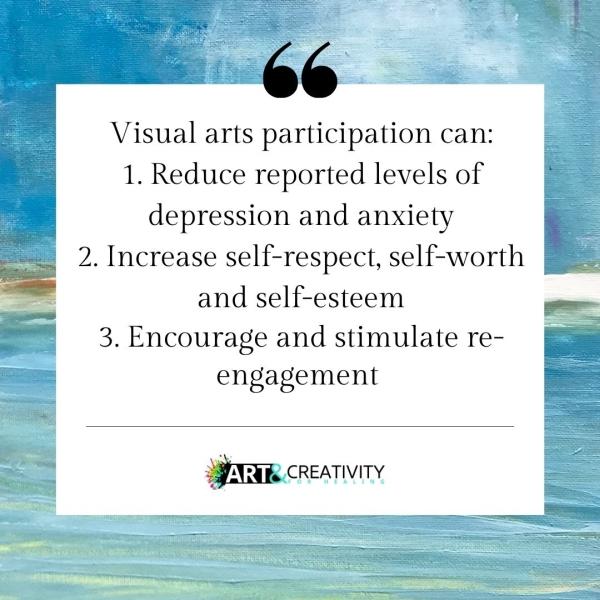
Although some negative dimensions of engagement with the visual arts did arise, the subjective wellbeing outcomes were positive for the majority of participants. This applied to men and women alike across the studies (Tomlinson, 2018).
Let’s look at nine positive wellbeing effects that were identified.
Nine Positive Wellbeing Effects from Art
Art had a positive wellbeing effect on study participants in nine main areas in the review (Tomlinson, 2018). We’ve also seen strong indications of these positive effects in our Art4Healing® workshop participants.

1. Social Dimensions / Human Relationships
“Bonding” was an important theme, as recognized explicitly in two of the studies.
Art4Healing® Participant Reactions
“This workshop allows you to get it all out without pressure. It is very refreshing. It helps to be surrounded by those who also need it.”
Military Base Wounded Warrior Participant
2. Stepping stone / Journey
Several studies and papers show how participants see and use the art based intervention as a ‘stepping stone’.
Art4Healing® Participant Reactions
“I healed my loss of a loved one with silence and becoming numb. After taking the Adult Bereavement class, I feel that I have now healed with love and strength. I haven’t felt this full since I have lost my loved one until now.”
Bereavement Series Participant
“This workshop was extremely helpful in opening me up to my emotions and allowing myself to be vulnerable. I never imagined art would make me open up to my emotions.”
Non Profit Family Resource Center Participant
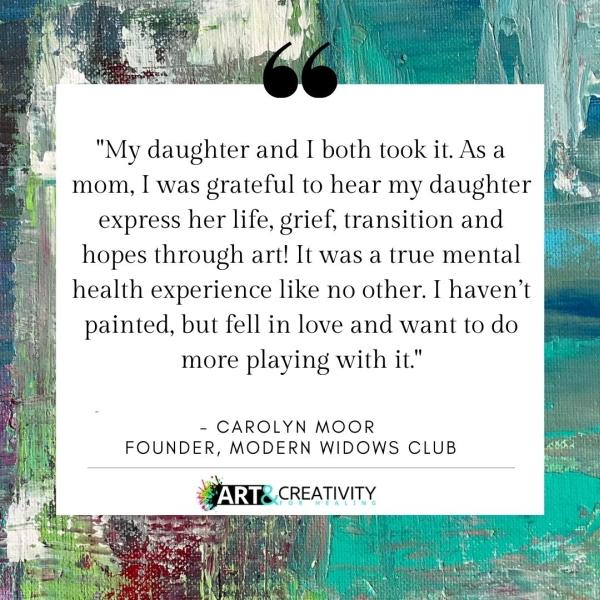
3. Achievement / Appreciation
The “making” element, the capacity to produce and sometimes display or exhibit artifacts or art, can generate respect in ways that made participants feel appreciated.
Art4Healing® Participant Reactions
“Before taking this class, I was never into art. So, thank you Art4Healing, for helping me put time into art and making me love it a lot. Now I have the motivation to do my own art designs and all my friends are hitting me up to paint something on their skate shoe!”
At-Risk Teen Participant
“I loved making the white clouds because I got to swirl the paint. Looking at my painting, I love the yellow sun in the middle. I left a little white showing so that the sun could come through. I am so happy with my painting. (after painting with the Painted Sky prompt)”
At-Risk Child Participant
4. Distraction / Safe Haven
The most effective study interventions took place in stigma free public spaces, such as galleries or museums, or community centers, where the participants could feel that they were not defined by the mental health world or system.
Art & Creativity’s dedicated studio space and online Zoom capabilities ensure participants a safe haven to express their feelings.
Art4Healing® Participant Reactions
“After hearing everyone share their stories, I felt compelled to share mine in this safe place. I have never shared these feelings with anyone before and it is a huge sense of relief for me.”
Military Base Wounded Warrior Participant
“I was always beaten for saying any negative feelings, so I found this very hard at first but I get how it’s a safe way to express those feelings and it felt good.”
Emergency Shelter Participant
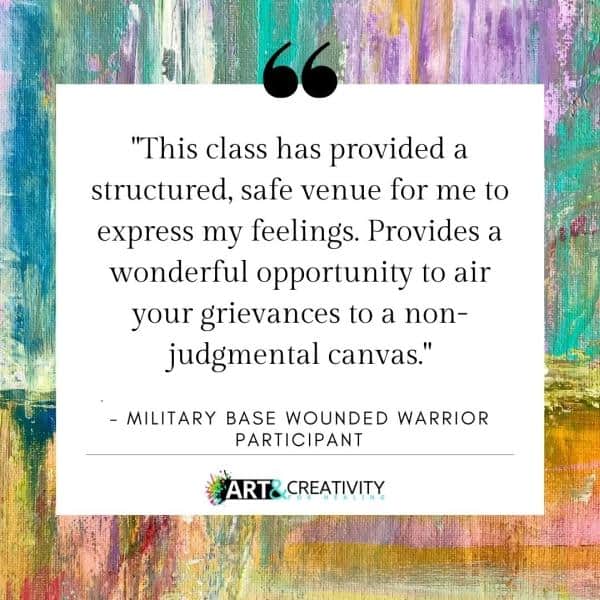
5. Doing/Action, Not Talking
To take on a commitment and enter a program is a giant stride for people who have been experiencing chronic social isolation, and the ‘doing not talking’ was a critical feature of the interventions for numerous study individuals.
Art4Healing® Participant Reactions
“Doing these exercises made me realize I have gotten away from art and doing creative things it helped me to release some tension with all the difficult things going on.”
Non Profit Family Resource Center Participant
“I’m not good at talking about my feelings or sharing them with others, but it was much easier to paint them, see them and then verbalize them.”
Military Base Wounded Warrior Participant
6. Confidence Building
Acquiring new skills can boost confidence and self esteem, in making art and exhibiting, in a private view for families or friends. Meeting new people can reduce everyday fears.
Art4Healing® Participant Reactions
“Painting made me realize how much I like to help others and it makes me feel good. I want to help people as much as I can.”
At-Risk Child Participant
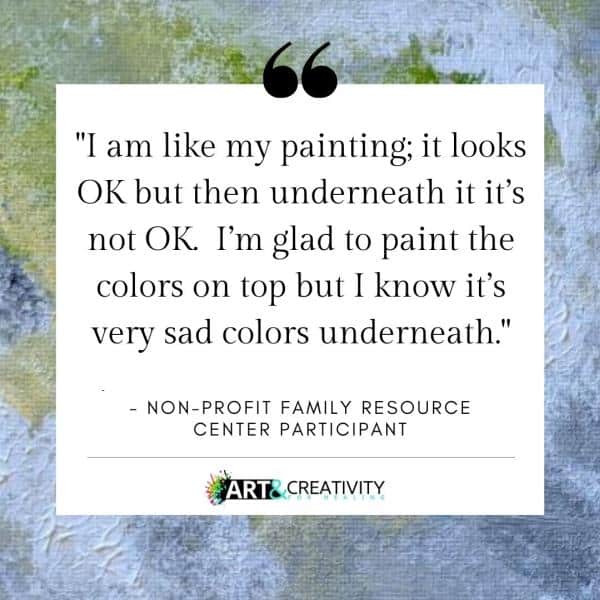
7. Identity gain
Engaging with and in the visual arts can provide a foundation for the renewal of identity. As one study participant said, “you’re not treated like a weirdo, you’re allowed to be you”.
Art4Healing® Participant Reactions
“I learned by doing this painting that there is still happiness in my life, it’s not all bad like I sometimes think I can see good too.”
Women’s Shelter Participant
“Art4Healing has helped me overcome and acknowledge feelings I didn’t know I had. I like that I can display all of my emotions. I’ve learned that painting helps so much with understanding myself.”
At-Risk Teen Participant
8. Improved Quality of Life
In the review, one study looked at an arts and crafts group suffering from PTSD. They significantly improved Quality of Life scores post intervention compared to pre intervention. Improved self rated health can also be a positive effect those who are experiencing burnout.
Art4Healing® Participant Reactions
“I really loved how this class opened me up and I could express so much gratitude. It helped me realize I have a second chance to be a better mom and live a clean and sober life for my son.”
Non Profit Family Resource Center Participant
“This workshop about hope made me feel so much better and hopeful for my future dream to have a house of my own and for my kids someday.”
Homeless Shelter Participant

9. Reduction in Trauma Symptoms / Reduced Exhaustion
Art has been shown to increase the self reported symptoms of trauma for those suffering from PTSD in studies in the review. Cultural activities can also reduce exhaustion for those experiencing burnout.
Art4Healing® Participant Reactions
“Today allowed me to express emotions on things that have been troubling me. I now feel calmer and more relaxed, filled with hope and joy.”
Military Base Wounded Warrior Participant
“Art4Healing makes me feel calm. I like painting and getting to talk about it. It taught me to never give up.”
At-Risk Teen Participant
Conclusion
This review of studies supports our 20 years of observations. Both suggest that expressive abstract art can positively help participants move through their individual grief path, whatever stage of grief they may be in. Grief is a unique, individual, and ongoing process. Art4 Healing® is a collection of creative tools that help participants give feelings like grief a voice when words fail.

Want More Information?
We’d love to hear from you today. We’re standing by to speak with you one-on-one about the power of healing art!
Online Courses
We have 35 courses available online! Relax and experience the Art & Creativity for Healing method in the comfort of your own space. All courses are only $29! Check out our course list and introduction video from Laurie here:
Online Courses: https://courses.art4healing.org/
Live Online Workshops
We offer a variety of live, online 2 hour workshops via Zoom! Visit our website for frequently asked workshop questions and our upcoming workshop calendar:
Live Online Workshop FAQ’s: https://art4healing.org/faq/
Workshop Calendar: https://art4healing.org/calendar/
Studio Workshops
We offer a variety of 3-hour workshops at our Studio on Laguna Hills! Visit our website for frequently asked workshop questions and our upcoming workshop calendar:
Workshop FAQ’s: https://art4healing.org/faq/
Workshop Calendar: https://art4healing.org/calendar/
Program Outcomes and Past Special Reports
We engage an outside party to help us compile Outcome Data for all of our Programs. We encourage you to visit our Results page, where you can view Outcome Data. We also have prior Special Reports available for you to review!
Art4Healing® International Certification Program Online
Can’t make it to our studio? We are proud to offer the only globally recognized Art4Healing® Certification, exclusively available online.
To become certified online, students experience and complete Art4Healing® workshops and assignments through an online platform within a timeline of 9 months (or less). Students are matched with an Art4Healing® Coach who will answer questions and review his/her assignments and facilitated workshops.
Painting Your Heart Out, by Laurie Zagon
Read the inspiring account of how Laurie Zagon started Art & Creativity for Healing, a Southern California non-profit organization that provides fine art workshops for children, teens, and adults suffering from abuse, illness, grief, or stress.
Learn from former students about the extraordinary impact that Art & Creativity for Healing has had on their lives. Art4Healing® Painting Your Heart Out is a non-threatening method that enables people who cannot draw a straight line to become successful in expressing their feelings through art. The creative process used in this book encourages participants to paint using abstract strokes of color on canvas to translate life’s everyday stresses.
Available on Amazon: https://www.amazon.com/Art-Healing-Painting-Your-Heart/dp/1517072247/
Works Cited
- Czeisler, M., Lane, R., Petrosky, E., & etal. (2020). Mental Health, Substance Use, and Suicidal Ideation During the COVID-19 Pandemic — United States, June 24–30, 2020. MMWR Morb Mortal Wkly Rep, 2020(69), 1049-1057. Retrieved from http://dx.doi.org/10.15585/mmwr.mm6932a1
- Gidlund, J. M. (n.d.). Art Therapy and Other Creative Modalities Used for Grief. Retrieved from Minds @ UW: https://minds.wisconsin.edu/bitstream/handle/1793/78499/Gidlund-Art%20Therapy%20and%20Other%20Modalities%20Used%20for%20Grief.pdf
- Kübler-Ross, E., & Kessler, D. (2005). On grief and grieving: Finding the meaning of grief through the five stages of loss. New York; Toronto: Scribner.
- Merriam Webster. (n.d.). Definition of Grief. Retrieved from Merriam Webster Dictionary: https://www.merriam-webster.com/dictionary/grief
- Molina, B., Monteiro-Leitner, J., Garrett, M. T., & Gladding, S. T. (2005). Making the connection: Interweaving multicultural creative arts through the power of group counseling interventions. Journal of Creativity in Mental Health, 1(2), 5-15. doi:10.1300/J456v01n02_02
- Tomlinson, A. (2018). Visual Art and Mental Health. London: What Works Centre for Wellbeing. Retrieved from https://whatworkswellbeing.org/wp-content/uploads/2020/01/Full-report-art-mental-health-wellbeing-Jan2018_0146725200.pdf
- Weiskittle, R. E., & Gramling, S. E. (2018, 02). The therapeutic effectiveness of using visual art modalities with the bereaved: a systematic review. Psychology Research and Behavior Management, 2018(11), 9-24. Retrieved from https://www.ncbi.nlm.nih.gov/pmc/articles/PMC5798551/
- Wikipedia. (n.d.). Grief. Retrieved from Wikipedia: https://en.wikipedia.org/wiki/Grief
